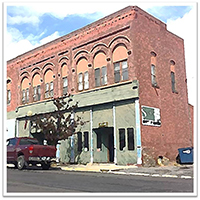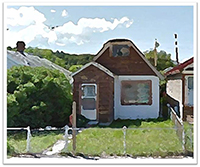Anaconda
At the time of its founding in 1883, the “Smelter City” of Anaconda quickly established itself as one of the state’s more ethnically diverse communities. Irish, Italian, and Slavic peoples, many born outside the United States, formed the earliest notable ethnic enclaves in Anaconda. By the late 1890s, Germans, Scandinavians, English, and an increasing number of African Americans began to flood to the Deer Lodge Valley in search of work at Marcus Daly’s Anaconda copper smelter. The City was conceived, drawn up, built and populated with thousands of eager workers and their families in about two years. Nearly every person worked for the smelter, or for businesses that served the many other needs of the smeltermen and their families. In this way, one social history of Anaconda is a story of how many different ethnic groups lived and worked together, largely for towards a similar goal. Interestingly, unlike other towns in Montana, the history of African Americans in Anaconda in many ways mirrors the history of other small ethic groups of the city, such as the Finns, or Swedes.
The first black residents of the area likely arrived around the same time of the city’s founding, as very few people lived in the valley prior to that time. One unconfirmed story tells of a black family living to the east of what would soon be Anaconda, nearer present day Opportunity, in the early 1880s, where a man worked as a stage coach driver at the stop located in the Deer Lodge Valley. More likely, the first African Americans came to find work at the smelter or in the service sector that the new city developed. Unfortunately, the best source that would have given historians a truly insightful glimpse into the early African American community in Anaconda, the 1890 Federal Census, was lost in a fire in Washington D.C. in 1921. As such, we are left with the censuses of 1900 and 1910 to analyze Anaconda’s early black history.
The 1900 census shows that the majority of the city’s 75 to 100 black residents were single men; some single women, and only four or five families also lived there. Compared to 1910 and 1930, where most black residents were married with families, the early decades of the city’s history shows the level of instability within the community. In line with the rest of Montana’s black communities, Anaconda began to flourish between 1910 and 1920. It was during this time that Anaconda’s business community established itself as a thriving economic driver. Many black men found permanent work for shops, bars, and stores throughout the city, as well as the traditional work for the smelter. With these more stable conditions, many African Americans bought or rented homes on the north side of railroad, near other black families. By 1930, far fewer black men and women lived in boarding houses or as lodgers, allowing a real physical community to thrive.
Several black men and women opened businesses in town, including Lee Pleasant Driver, whose story can be explored in the Driver Family Story Map. Driver’s Saloon and Club Rooms at 104-106 E. Commercial operated from 1909-1917 before he retired to his ranch East of Opportunity. Marian Reynolds also thrived as a businesswoman in Anaconda, operating the Vogue clothing boutique at 209 Main Street in 1910, as well as working as a Milliner for Dr. McCrea’s Clothing Store. In addition to developments in the business community, African Americans also began to enhance their social lives during this time. The Reverend Jordan Allen of the African Methodist Episcopal Church founded the city’s only black church in 1903. The church at 305 West Commercial, later named Allen Chapel, operated until 1947 as place of worship and community enrichment for Anaconda’s black residents.
Like the rest of the state, Anaconda’s black population fell substantially during the interwar period, and continued that trend after World War II. Very few black families remained in Anaconda in 1981, when the Anaconda Company ended its smelting operations, eliminating the jobs of a majority of the city’s residents. Today, the stories of Anaconda’s many different ethnic communities are told by the descendants of the Irish, Italians, Slavs, and others who had called Anaconda home. However, with so few descendants of Anaconda’s early black community still living there, the legacy one of the most unique ethnic and social group threatens to be lost. What does remain are some the buildings and homes that will forever be tied to the early African American community of Anaconda, Montana.
Anaconda Historic Properties

Lee Pleasant Driver's Saloon and Club Rooms
23 Main Street

Frank & Sarah Q. Walker Residence
516 Spruce Street
